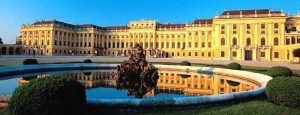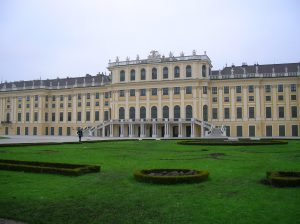Schönbrunn Palace in Vienna
By Tracy A. Burns
Proclaimed a UNESCO World Heritage site in 1996, the majestic SchönbrunnPalace with its yellow façade boasts state rooms and private apartments on the piano nobile, splendid monument-filled parks, and a zoo. The glory days of Empress Maria Theresa’s reign were lived out here, and this is where Emperor Franz Joseph was born and died. American President John F. Kennedy even met with Soviet Premier Nikita Khrushchev in a stunning hall at the palace.
History of the palace
 But the palace’s history dates much farther back, all the way to the beginning of the 14th century. In 1569, when it was a country estate, the Habsburgs took it over, and Emperor Matthias hunted there. Legend has it that in 1612 the emperor came across a “fair spring,” – in German “schöner brunnen” – from which the palace got its name. After Emperor Ferdinand II died, his widow Eleonora of Gonzaga transformed the estate into a chateau during the middle of the 17th century. However, the building was badly damaged during the Turkish siege of Vienna in 1683. Emperor Leopold, I proved its savior, rebuilding the palace in 1686.
But the palace’s history dates much farther back, all the way to the beginning of the 14th century. In 1569, when it was a country estate, the Habsburgs took it over, and Emperor Matthias hunted there. Legend has it that in 1612 the emperor came across a “fair spring,” – in German “schöner brunnen” – from which the palace got its name. After Emperor Ferdinand II died, his widow Eleonora of Gonzaga transformed the estate into a chateau during the middle of the 17th century. However, the building was badly damaged during the Turkish siege of Vienna in 1683. Emperor Leopold, I proved its savior, rebuilding the palace in 1686.
The palace’s golden age and afterward
Emperor Charles VI gave Schönbrunn to his daughter, Maria Theresa. Her tenure there marked the golden age of the palace where the Habsburg clan stayed during summers. Breathtaking Rococo decoration, including stucco and frescoes that can still be seen today, originated from 1755 to 1761. During the 1770s the garden got a makeover as it was adorned with many statues and sculptures. Schönbrunn’s glorious days ended with Maria Theresa’s death in 1780. From that time no one lived in the palace until the beginning of the 19th century. It was taken over twice by Napoleon, in 1805 and 1809. The public could stroll in the parks and gardens from 1779, and even the staterooms were open by appointment.
The west wing with the Walnut Room
Elegant blue stairs lead upstairs to the west wing. The thrilling Walnut Room got its name from walnut wall paneling created in 1765. The stunning panels are framed with gilded molding. Gilt rocaille –ornamental Rococo combinations made of rock, shell, plant forms, or artificial forms – adds to the astounding décor. The chandelier has 48 arms, and the furniture boasts Rococo. It was in this room that anyone living in the Monarchy could meet with Emperor Franz Joseph.
Franz Joseph’s study and bedroom
While the Walnut Room is extravagant, Franz Joseph’s study is strikingly different from this lavish nature because it is so plain. Franz Joseph’s bedroom is spartan as well, furnished without any frills. An iron bed, a praying stool, and a marble washstand make up the decor. He died on this modest bed at age 86 in November of 1916.
Elisabeth’s apartments and the Mirrors Room
Among Elisabeth’s apartments, the Empress’ Salon is sure to delight with its splendid décor of silk wall hangings as well as white and gold paneling. The clock in front of the mirror has a reverse image on the back so that the empress could tell the time while looking into the mirror. The Mirrors Room is sure to fascinate with its white and gold ornamentation plus crystal mirrors. When he was six years old, Wolfgang Amadeus Mozart played the harpsichord for Maria Theresa and then jumped onto her lap.
The Great Gallery and East Asian Cabinets
The Great Gallery is one of the highlights of the tour. With a length of 43 meters and a width of almost 10 meters, the gallery was once used for balls and banquets. It was here that American President John F. Kennedy negotiated with Soviet Premier Nikita Khrushchev in 1961. The ornamentation is lavish – white and gold stucco decor, tall crystal glass mirrors, and ceiling frescoes dating from the mid-18th century shout Rococo. The East Asian Cabinets are intimate, sporting chinoiserie furniture that shows intricate Chinese patterns and motifs. Silk wall hangings as well as Japanese and Chinese porcelain also adorn the space. The walls are stunning. White paneling and gilded rocaille décor are prominent. Chinese lacquer panels show landscapes, flowers, and birds. Rococo chandeliers round out the beauty of this space.
The Carousel Room and the chapel
The Carousel Room is also sure to charm. Its rocaille work, sculptural décor, and gilt stucco enthrall. On the vaulting of the white-painted panel spears and banners appear, demonstrating the strength of the Habsburg Empire. Huge paintings also decorate the room. The largest is remarkable for its attention to detail in its buildings (including the Hofburg Palace), people, and attire. More than 90 carriages, drawn by six horses each, appear as does a blue and silver coach with the bride, Isabella of Parma, marrying Joseph, heir to the throne in 1760. The Palace Chapel includes an incredibly large high altar, stunning side altars, and a breathtaking ceiling painting.
The East Wing: The Blue Chinese Salon and Vieux-Laque Room
In the east wing, the Blue Chinese Salon enthralls with 19th-century Chinese rice paper on the walls. Scenes created with black ink and bronze paint frame flowers and bamboo. The room has historic resonance, too. It was here that the last Habsburg Emperor Karl I announced he would no longer play a role in the government during 1918, though he did not formally abdicate from the throne. His decision paved the way for the creation of a Republic and ended Schönbrunn’s function as an imperial residence. The Vieux-Laque Room commemorates Maria Theresa’s husband, Franz Stephan, with black Chinese lacquer panels and walnut paneling. The walls and doors have gold frames. The lacquer panels boast landscapes as well as flowers and birds.
The Millions Room
The Millions Room is another highlight and gets its name from the million silver coins that Maria Theresa paid for its creation. The wall paneling is made from a rare type of rosewood. The wooden paneling shows off several 17th-century Indo-Persian miniatures made elegant by gilt rocaille. The miniatures represent scenes of the life of Mogul rulers in India during the 16th and 17th centuries. During World War II the paneling was saved because it was stored in a salt mine to make sure it would not be destroyed. Unfortunately, the room was under renovation when this article was written, at the beginning of 2013.
The Gobelin Salon and the Rich Room
The Gobelin Salon is dominated by 18th-century tapestries from Brussels that illustrate scenes at a marketplace and in a port. The tapestry upholstered armchairs are fascinating; they boast scenes from the months of the year and signs of the zodiac. Franz Joseph was born in the Rich Room, where now the only surviving ceremonial bed from the Habsburg monarchy is displayed. Created in 1737, it includes a luxurious canopy, textile wall panels, and curtains made of red velvet and embroidered with gold.
The gardens and more
 The gardens are planned in Baroque style and flaunt monuments such as the Neptune Fountain, which shows Neptune with an entourage of half-man and half-fish figures. The Gloriette boasts a neo-Classical colonnade. It is topped with the Habsburg eagle perched on a globe. The Obelisk Fountain includes a grotto and figures of river gods and is crowned by an obelisk boasting hieroglyphics. The cascades add to the splendor. The oldest Baroque zoo in existence, established in 1752, is also on the premises. There is also an Imperial Carriage Museum and a conference center. Tickets to the palace, gardens, and Gloriette as well as to the Hofburg Palace can be purchased in person or online at https://www.schoenbrunn.at/en.html in English. Other language options are German, Italian, and French. Two tours of the palace are available – one taking the visitor into 22 rooms and the longer version of 40 rooms. The palace is a 20-minute Metro ride from the center of Vienna.
The gardens are planned in Baroque style and flaunt monuments such as the Neptune Fountain, which shows Neptune with an entourage of half-man and half-fish figures. The Gloriette boasts a neo-Classical colonnade. It is topped with the Habsburg eagle perched on a globe. The Obelisk Fountain includes a grotto and figures of river gods and is crowned by an obelisk boasting hieroglyphics. The cascades add to the splendor. The oldest Baroque zoo in existence, established in 1752, is also on the premises. There is also an Imperial Carriage Museum and a conference center. Tickets to the palace, gardens, and Gloriette as well as to the Hofburg Palace can be purchased in person or online at https://www.schoenbrunn.at/en.html in English. Other language options are German, Italian, and French. Two tours of the palace are available – one taking the visitor into 22 rooms and the longer version of 40 rooms. The palace is a 20-minute Metro ride from the center of Vienna.


